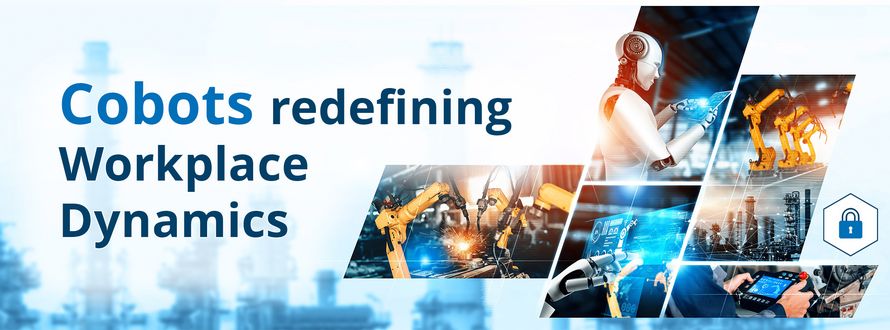In an era where technological advancements are reshaping industries as never seen before, cobots have emerged as a beacon of innovation, revolutionizing workplace safety and efficiency. Cobot stands for "collaborative robot" and is a type of robot designed to work alongside humans in a shared workspace for industrial automation. Unlike traditional industrial robots, cobots are equipped with advanced sensors and AI capabilities that enable them to perceive their environment and interact safely with human workers.
Collaborative Revolution: The Rise of Cobots
Cobots represent a paradigm shift in automation. The integration of cobots into diverse industries is reshaping traditional notions of labor and productivity. By augmenting human capabilities, cobots empower workers to focus on tasks that require creativity, problem-solving, and emotional intelligence, while repetitive and hazardous tasks are delegated to robotic counterparts. This collaborative approach not only enhances efficiency but also fosters a safer work environment.
From manufacturing plants to healthcare facilities, cobots are making significant strides in enhancing workplace safety. In manufacturing, cobots assist with heavy lifting, assembly tasks, and repetitive motions, reducing the risk of ergonomic injuries for human workers. In healthcare settings, cobots aid in patient care by handling sterilization processes, medication delivery, and logistics, minimizing the potential for human errors and cross-contamination.
Precision and Accuracy: Cobots in Quality Control
In industries where precision and accuracy are paramount, such as electronics and automotive manufacturing, cobots play a crucial role in quality control processes. Equipped with advanced vision systems and LiDAR (Light Detection and Ranging) sensors to measure the distance between object and vehicle, cobots can inspect products with unparalleled speed and accuracy, detecting defects and anomalies that may elude human eyes. By automating quality assurance tasks, cobots help maintain product integrity while ensuring compliance with stringent standards.
As technology continues to evolve, the potential applications of cobots in ensuring accuracy, quality and workplace safety are limitless. From collaborative construction robots that assist with building infrastructure to cobots deployed in hazardous environments such as mining and oil rigs, the future of cobotics holds promise for transforming industries and safeguarding human lives. By embracing cobots as partners in innovation, organizations can pave the way for a safer, more efficient future.
Collaboration and Autonomy: Artificial Intelligence and Navigation
Artificial intelligence (AI) plays a pivotal role in advancing the capabilities of cobots, particularly in facilitating seamless collaboration with human workers. AI algorithms enable cobots to analyze and interpret complex data from sensors and vision systems in real-time, allowing them to adapt their behavior dynamically based on the surrounding environment. For example, AI-powered cobots can recognize and respond to human gestures, voice commands, and facial expressions, enabling more intuitive and natural interactions between humans and robots. Moreover, AI algorithms enable cobots to learn from experience, continuously improving their performance and efficiency over time.
Navigation is another critical aspect where technology partners like Intel contribute to the development of cobots. Intel's hardware platforms and software solutions provide the computational power and algorithms necessary for autonomous navigation and path planning. Through a combination of sensors, such as LiDAR, cameras, and inertial measurement units (IMUs), cobots can accurately perceive their surroundings and navigate autonomously in dynamic environments. Advanced navigation algorithms enable cobots to avoid obstacles, optimize paths, and adapt to changes in the workspace, from factory floors to warehouses, in real-time.
Increasing Safety Requirements
As cobots are moving and acting, the requirements for safety increase. Therefore, moving cobots have a virtual safety area around them surveyed by the LiDAR sensors to observe human beings or other obstacles and - if detected - go to idle mode. When leaving the zone, the system goes back to normal operation mode. For such kind of systems, a safety certification level is needed based on IEC 61508 at level SIL 2 or higher.
Leading the Industry: Coboting together
SYSGO, NexCOBOT, and Intel each play important roles in the ecosystem surrounding cobots:
SYSGO: SYSGO is specialized in real-time operating systems (RTOS) and hypervisors for safety-critical embedded applications. In the context of cobots, SYSGO provides software solutions that ensure the reliable and secure operation of the underlying robot system. Our PikeOS RTOS and hypervisor technology is crucial for managing the real-time processing requirements, applications and other Guest OS such as POSIX while maintaining functional safety (certifiable up to SIL 2/3) and reliability standards.
NexCOBOT: NexCOBOT is a provider of industrial-grade automation solutions, including cobots. They offer a range of cobot products and services designed to enhance productivity and safety in manufacturing and other industries. NexCOBOT's cobots likely incorporate advanced features such as collaborative capabilities, precision control, and safety mechanisms to facilitate smooth interaction with human workers.
Intel: Intel, as a leading technology company, contributes to the cobot ecosystem through its hardware chip solutions and dedicated safety island, that is already pre-certified. Intel's processors and computing platforms power many cobots, providing the computational horsepower needed for tasks such as machine learning, computer vision, and real-time control. Additionally, Intel offers development tools and frameworks that enable cobot manufacturers to optimize performance and develop innovative applications.
Conclusion
In an increasingly interconnected world, cobots represent more than just machines; they embody a collaborative vision for the future of work. By harnessing the power of automation while prioritizing human-centric design, cobots are not only reshaping industries but also redefining the very notion of workplace safety. As we embrace this transformative technology, we embark on a journey towards a safer, more sustainable future where humans and robots work hand in hand to accomplish outstanding achievements. Partnerships between cobot manufacturers and technology providers will likely continue to drive innovation in areas such as artificial intelligence, human-robot interaction, and autonomous navigation.
SYSGO provides the critical and powerful software infrastructure with PikeOS, NexCOBOT delivers cobot hardware and automation solutions, and Intel contributes computing power, pre-certified hardware safety elements and tools, all of which are essential components in the development and deployment of cobots for enhanced safety and productivity.

